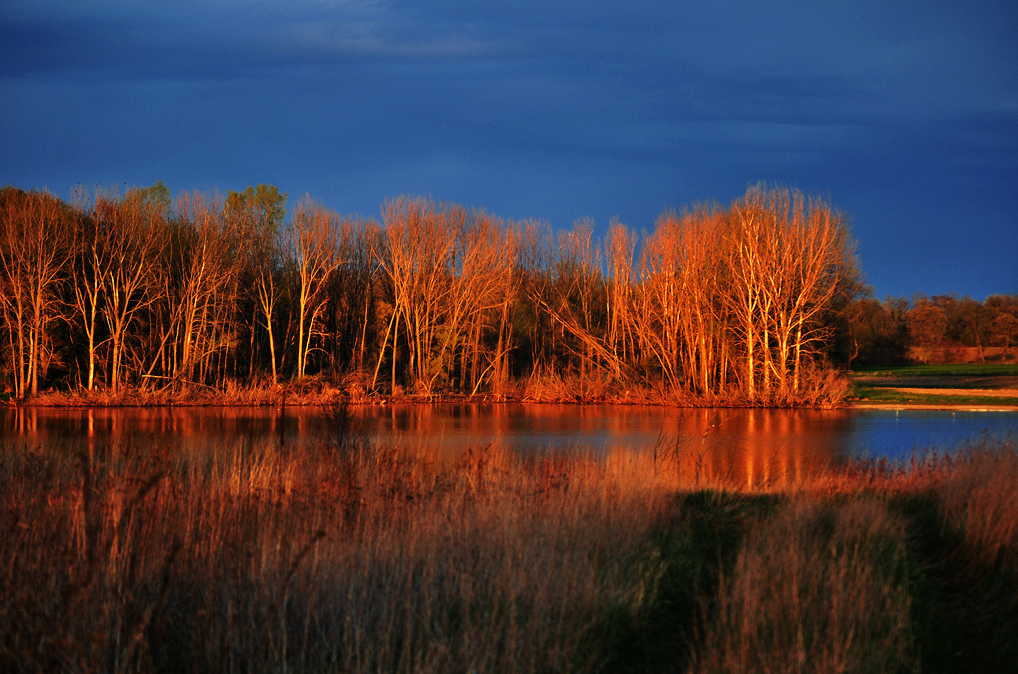More properties to explore
In addition to Fair Meadows, Faville Grove, Goose Pond, and Otsego Marsh, Southern Wisconsin Bird Alliance (formerly called Madison Audubon) owns and manages several other parcels of land in Columbia and Jefferson County.
Erstad Prairie
Southern Wisconsin Bird Alliance’s 60-acre Erstad Prairie is adjacent to the U.S. Fish and Wildlife Service’s 720-acre Waterfowl Production Area at Schoenberg Marsh. The parcel, three miles northeast of Goose Pond, contains two 18-acre wetlands and 42 acres of upland grassland. Schoenberg Marsh is one of the premier prairie wetlands in Wisconsin with nesting Yellow-headed Blackbirds and Black Terns. There is a Fish and Wildlife Service handicap accessible trail on Priem Road, and a Southern Wisconsin Bird Alliance wildlife viewing blind past the end of Harvey Road. The entire parcel is open for fall hunting.
Historically known as the Empire Prairie, Erstad Prairie along with Goose Pond Sanctuary are part of a 5,800-acre Northern Empire Prairie Wetlands Important Bird Area that draw species of birds attracted to the shallow wetlands, sedge meadows, oak savannas, remnant and restored prairies, and deep-water marshes. Large spring and fall migrations of waterfowl, including Tundra Swans, make these sites a popular birding destination. Viewing birds at these properties is best from the main roads and driveways by using your car as a blind, taking care not to flush birds by walking down to water.
Southern Wisconsin Bird Alliance’s Erstad Prairie in Columbia County, offer acres of wetlands and other wildlife habitat. A viewing blind in the Erstad Prairie is an excellent place to observe wildlife on the wetland. Cover photo courtesy of Peter Patau.
HIGHLIGHTS
Visit Schoenberg Marsh as you follow the southern savanna portion of the Great Wisconsin Birding and Nature Trail.
Visit the wheelchair accessible trail at Schoenberg Marsh on Priem Road.
Use the Southern Wisconsin Bird Alliance viewing blind at the end of Harvey Road to observe migrating waterfowl like tundra swans.
Snapper Prairie
Located less than one mile north of Faville Prairie, Snapper Prairie is a small 30 acre remnant of what was once a large 2,500 acre low prairie in the floodplain of the Crawfish River. Depending on rainfall and moisture conditions, the prairie may flood in spring and early summer due to poorly drained clay soils, but may later appear very dry by mid-summer. The prairie is dominated by big bluestem, little bluestem, and prairie dropseed grasses, and has many showy forbs including prairie blazing-star, coneflowers, compass-plant, sky-blue aster and a large population of prairie dock. Several plants indicative of alkaline conditions and more often found in fens, grow here—Riddell's goldenrod, nodding ladies-tresses orchid, valerian, and narrow-leaved loosestrife.
Arthur and Albena Snapper Memorial Prairie is a State Natural Area at Southern Wisconsin Bird Alliance’s Faville Grove Sanctuary. Prairie Indian plantain cover photo by Joshua Mayer.
Rare plants include prairie milkweed and prairie Indian plantain. There are good populations of Savannah Sparrows and Eastern Meadowlarks present while Bobolink and rare Upland Sandpipers have nested on the prairie in the past. Small mammals, including meadow voles, shrews, and white-footed mice, are abundant. Snapper Prairie was designated a State Natural Area in 1981.
Highlights
Rare and showy prairie forbs such as prairie milkweed, ladies tresses orchid, and prairie milkweed
Upland sandpiper nesting habitat
Hope Lake Bog
Hope Lake Bog, managed by Southern Wisconsin Bird Alliance, is near Faville Grove Sanctuary. It is a botanical preserve, with fragile plant life. No public access is allowed at Hope Lake Bog. Bog Rosemary cover photo by Joshua Mayer.
Hope Lake Bog is a 35 acre botanical gem known to generations of Wisconsin conservationists. This small floating tamarack and sphagnum bog is a long, narrow 35-acre tract separated from the main part of Zeloski Marsh. Two wooded glacial moraines drop steeply toward a narrow wetland that runs most of the length of the property. Common plants include poison sumac, pitcher plants, cotton grass, leatherleaf, bog rosemary, bog birch, and cranberry.
Due to the fragile nature of this ecosystem, Hope Lake Bog is being preserved as an undisturbed sanctuary. There is no public access to the Bog.
Banner photo: Black tern over Otsego Marsh. Photo by Arlene Koziol.







